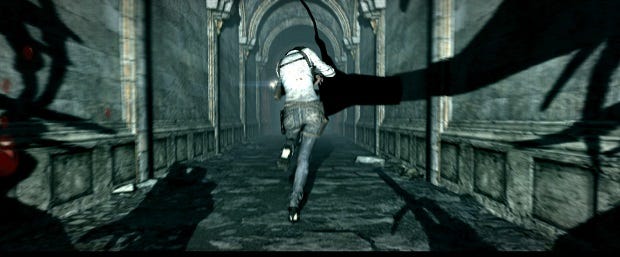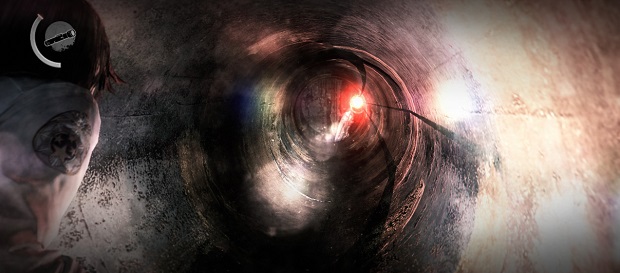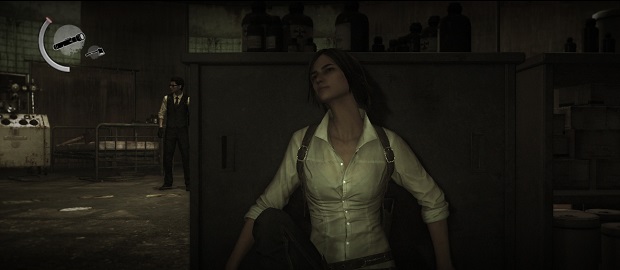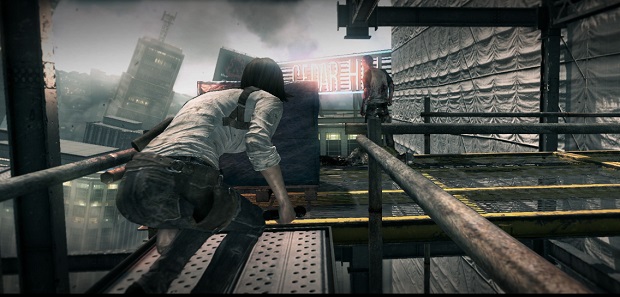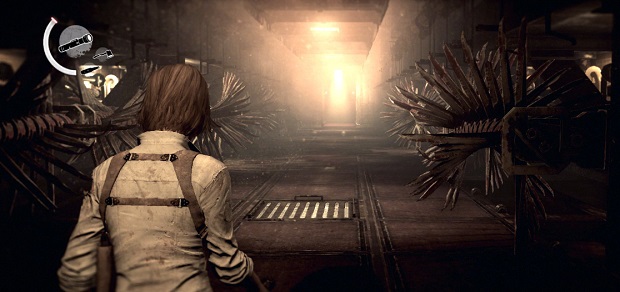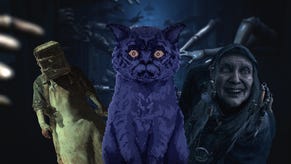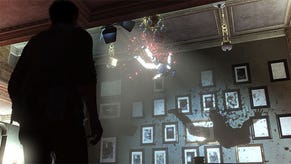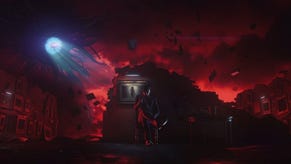Wot I Think of The Evil Within's DLC
More horror, less gunplay – a recipe for success?
The Evil Within [official site] is one of those gems that, because it was released in that pre-Christmas period when EVERY GAME IS, went a little under-appreciated. Basically it's a fantastic re-working of the survival horror genre, and in particular Resident Evil, as psychological torment rather than biological gauntlet – and my opinion of it increases over time. But with two pieces of DLC, both now released, developer Tango Gameworks has moved TEW even further away from the action beats of its inspiration.
Click to once again enter the world of survival horror.
To explain the DLC's setup requires some mild spoilers for the original game's storyline. The Evil Within's campaign focused on Sebastian Castellanos, an alcoholic cop pulled into a nightmare world controlled by a nasty sort called Ruvik. One of Castellanos' cop buddies, Julie Kidman, is also pulled in and eventually seems to betray him – though both her actions and motivations are less than clear. The Assignment (released in March) and The Consequence (released a few days ago) together form a mini-campaign that follows Kidman from her initial involvement with a sinister outfit before crossing-over into the events of the main game.
There are major differences between controlling Kidman and Castellanos, and the most far-reaching is that she doesn't have an armoury at her disposal. Where Castellanos has a gun from the first moments and is toting magnums and rocket launchers by the finale, Julie's main tool is a torch and the ability to shout. Throughout both DLC campaigns the emphasis is on avoiding enemies wherever possible and, if you're spotted, hiding as fast as possible: Julie's health regenerates but the pool is low, and even on Normal ('Survival') difficulty two quick hits will kill you. Most of the enemies save time by doing it in one. This is no power fantasy.
Avoiding confrontation is the most important of several big shifts in emphasis with the DLC, and it could have been disastrous – after all, one of the most finely-tuned and beautiful parts of the original game is the combat system. But it works because the enemy encounters are kept low-key, and the environments are cramped. The challenge here, initially at least, is in getting around one inconveniently-placed foe rather than taking out crowds of them.
Kidman creeps around enemies using both distraction and cover. The first is handled by tossing bottles and the odd environmental interaction, as well as the ability to shout from cover. This pulls enemies around but the paths they'll take are worryingly erratic, so it's rarely a smooth process. Staying crouched or in cover is paramount, and the killer detail in any cover system is how well the developer has managed context-sensitive movement – basically, when you pull away from a wall and want to move, but the game insists you press the button first. The Evil Within doesn't quite nail this, but nor is it too far off, and never becomes frustrating. If this was a more frantic shooting-focused campaign it may have been more of an issue but, as it is, your actions are always slow and considered.
This style of play is helped enormously by the fact that TEW's atmosphere is so oppressive in the first place, but the DLC increases this (!) by also focusing on light. Most of the environments are dark, sometimes pitch-black, and your torch is often permanently raised which reduces Kidman to a walking pace. This might sound annoying, and in other games surely would be, but the fact is that you never want to move fast anyway – the threat of what might be lurking nearby is so pronounced that running only ever enters your head when everything's gone to hell.
It's not all shouting and sneaking, and you'll stumble across single-use hatchets that can take out an enemy from behind. These are another neat addition because they're rare enough you're tempted to hoard, or at least save them for a rainy day, but the inventory only allows Kidman to carry one. And of course as the campaign progresses there's some catharsis – after all that hiding there's a set-piece with a magnum and infinite ammo, before the closing hours give you first a handgun (swiftly removed) and eventually a booming shotgun that turns erstwhile tormentors into mush.
As this might suggest, Kidman's campaign is really about the set pieces – which run the gamut from small-scale encounters to scenery-collapsing madness. The rhythm is what's special. I'm usually not a fan of developers limiting interaction for the sake of a marquee moment, but TEW’s approach is to focus exclusively on one mechanic for an instant, then move on. The repetition is minimal: there are two sequences over the DLC's 5-6 hours where Kidman is sprinting from big bad nasties, and in both you're trying to dodge left and right while staying on the correct route. Both last between 30 seconds to a minute, and are relatively easy challenges (I didn't die on either). This makes them refreshing, especially when you've been creeping around in darkened rooms, and the brevity makes it impossible to resent the temporary removal of Kidman's usual moves.
The finest sequences involve Kidman's own bête noire, a searchlight-headed maw wrapped in a medical coat that staggers around on a woman's legs. This thing might sound horrible but just wait till you're in the same room, watching the light flick back and forth as it searches. If it gets near Kidman that's that, it swallows her in one gory gulp, and the most wicked thing about the design is that it can slow Kidman's movement when chasing. That's right: if it catches sight of you the searchlight beam changes from white to red and Kidman starts flipping out, moving more groggily as it shambles closer.
First of all, the idea of a 'hunter' enemy in a thirdperson game whose proximity can be judged by light – you see the searchlight hitting Kidman's back and the walls ahead of her – is nothing less than brilliant. The way it slows you is a bit cheap, but being around this thing is so terrifying that the mechanic seems like a digital embodiment of Kidman's own fear. There are a few encounters with this thing and the best is a hoary old classic rejuvenated: you're in a server room, and have to wait for an elevator to arrive while staying hidden. When I managed this, on my third attempt, I went to celebrate with a cup of tea and a calm down.
Certain issues that affected the original game are carried over: the texture pop-in is noticeable, and occasionally the camera has trouble with an especially cramped room. But these are minor things and dwarfed by what the DLC gets right. So many games are expanded by bulking out what was already there – more of the same, basically. TEW's DLC has much in common with the original game - of course it does - but in turning the focus away from combat it becomes a distinctive experience.
Despite the minor issues The Evil Within's DLC shows both that a big-budget horror game doesn't necessarily need guns - which is an obvious point but worth making in an industry obsessed with firearms - and also that Tango Gameworks is no one-man show. Shinji Mikami has spoken of how he feels a responsibility to nurture the next generation of talent at his studio, and TEW's model – where Mikami directed the main game and the up-and-comers get a shot at the DLC using that solid foundation – has worked out well. First-time director John Johanas should take a bow.
The two parts form a mini-campaign every bit as scary as the main story, and illuminate what was going on in the first place. There are times when playing that you'll be inching forwards as slowly as possible, barely touching the analogue stick, not from fear of an immediate threat but simple fear of this world. The Evil Within felt under-appreciated at release, and aficionados may well look back in years to come and recognise a masterpiece of the genre – for them and latecomers, the DLC adds much.
The Assignment and The Consequence are dark, they're frightening, they get the blood pumping, and there's nothing else quite like them around. You'll know when you've been Tango'd.
Rich's thoughts on the original game and its links to Resident Evil are well worth reading.
